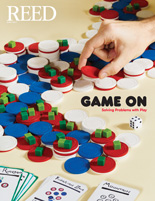
IRIS login | Reed College home Volume 96, No. 2: June 2017
Field Trip to the Future of the Brain

Reed students infiltrate NeuroFutures 2015. From left: Jason Swinderman ’15, Rose Driscoll ’17, lab associate Greta Glover (kneeling), Mical Yohannes ’17, and James Fisher-Smith ’17. Suzy Renn
Reed biology research students took a field trip to the future this summer at the 2nd annual NeuroFutures conference sponsored by the Oregon Health & Science University Brain Institute in Portland last week.
Scientists at top institutions from around the nation presented their cutting-edge research on new technologies in brain imaging, brain mapping, and brain implants used to treat disease. One scientist presented her recent work on how to turn a gene that senses heat from a chili pepper into a remote-controlled brain “stimulation electrode.” She also talked about her work in engineering a device that could manipulate brain cells by shining a blue light down a microscopic tube implanted in a patient’s spine.
Other talks dealt with the massive effort to map the circuitry of the brain, and how the development of new automation techniques has drastically improved the rate of progress on this complex project. The presentations riveted the Reed students who attended, took notes, and asked questions.
Leah Cepko ’16, a student in Prof. Sarah Schaack's lab this summer, commented that “seeing such a diverse group of researchers, presenting distinct perspectives of both basic science research and biomedical advances, was extremely eye-opening." Rose Driscoll ’17, a student in Prof. Suzy Renn's summer lab, noticed a little scientist snarkiness coming through during the questioning period after one talk, and remarked, “It was a bit of a game of ‘my technique is better than your technique’.” However, Morgan Vague ’17, a student in Prof. Erik Zornik's summer lab, saw that these same two researchers later “exchanged contact information and seemed overtly friendly.”
After the series of talks, students mingled with principal investigators, graduate students, and postdocs who were presenting their work in poster format. Morgan commented she had found her science hero in Polina Anikeeva, a materials scientist from MIT. Lunch hour came and went, but the students were too busy talking to scientists, asking questions, and learning about their work. Prof. Renn, who organized the trip, admitted that all these new technologies and possibilities made her want to return to grad school! Attending scientific meetings is a great way to learn about new research, meet the people doing it, and get inspired. The experience will be useful for Reedies as they prepare their own presentations for Reed's Summer Research Poster Session in September.


LATEST COMMENTS
steve-jobs-1976 I knew Steve Jobs when he was on the second floor of Quincy. (Fall...
Utnapishtim - 2 weeks ago
Prof. Mason Drukman [political science 1964–70] This is gold, pure gold. God bless, Prof. Drukman.
puredog - 1 month ago
virginia-davis-1965 Such a good friend & compatriot in the day of Satyricon...
czarchasm - 4 months ago
John Peara Baba 1990 John died of a broken heart from losing his mom and then his...
kodachrome - 7 months ago
Carol Sawyer 1962 Who wrote this obit? I'm writing something about Carol Sawyer...
MsLaurie Pepper - 8 months ago
William W. Wissman MAT 1969 ...and THREE sisters. Sabra, the oldest, Mary, the middle, and...
riclf - 10 months ago